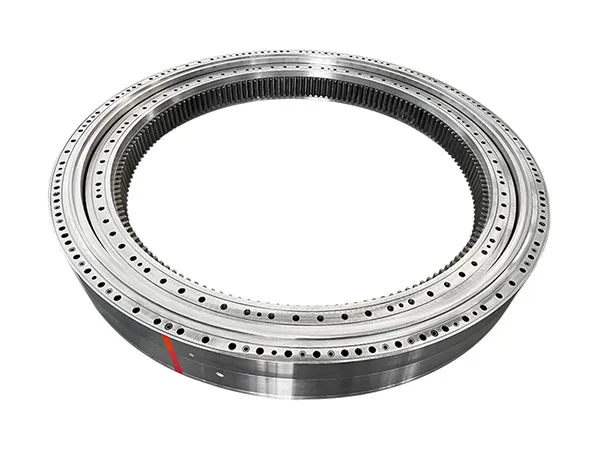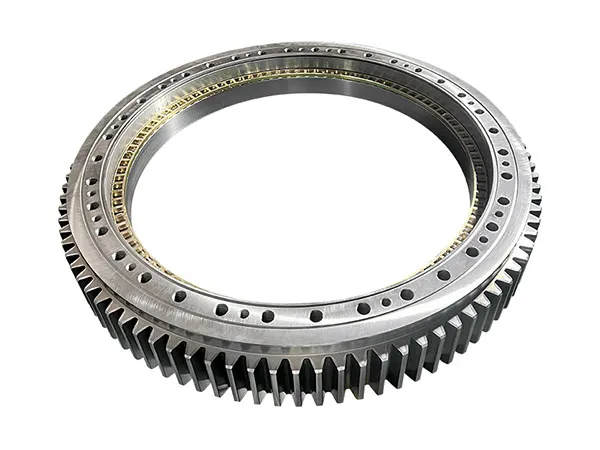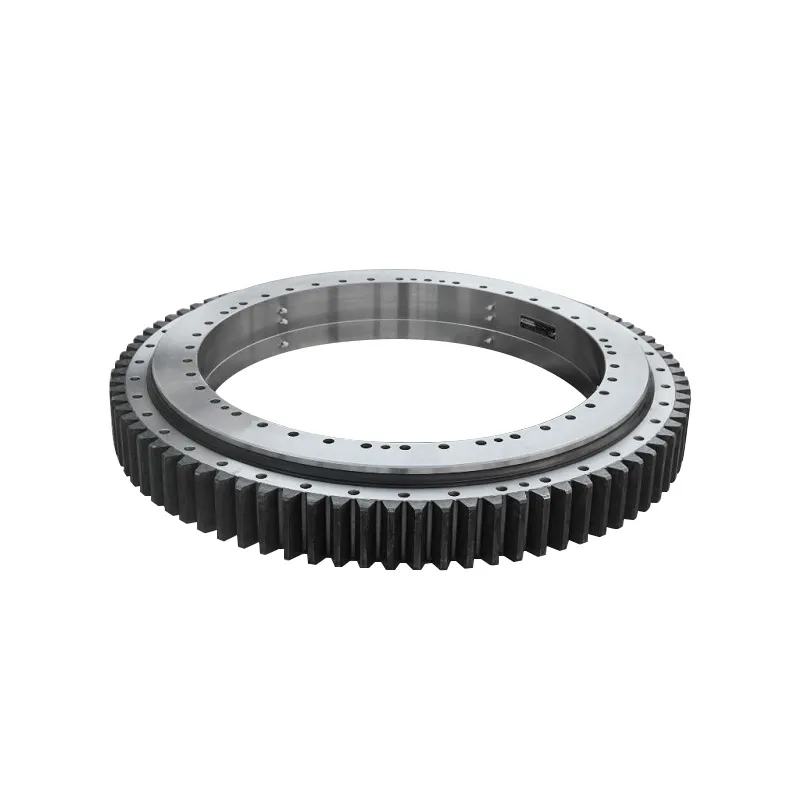- +86 13837949030 +86 15890619536
- info@lymcbearings.com export@lymcbearings.com
- Luoxin Industrial Cluster, Luoyang City,Henan Province,China
Time:2025-03-21 07:45:18 Source:Luoyang MC Bearing Technology Co.,Ltd.
Choosing the right material for a slewing bearing is crucial for its performance, longevity, and overall cost-effectiveness. The "best" material depends heavily on the specific application, load requirements, environmental conditions, and budget.

Races (Rings): Typically made from hardened steel.
Carbon Steel (e.g., 1045, 1050): Most common and economical choice for light to medium-duty applications.
Alloy Steel (e.g., 4140, 4340, 50CrMo4, 42CrMo4): Offers higher strength, toughness, wear resistance, and hardenability. Used for medium to heavy-duty applications.
Stainless Steel (e.g., 304, 316, 440C): Used in corrosive environments or where hygiene is critical (food processing, marine applications, medical equipment). 440C is often used for races that require hardening.
Rolling Elements (Balls or Rollers): Usually made from high-carbon chromium bearing steel.
High-Carbon Chromium Bearing Steel (e.g., 52100, 100Cr6): The industry standard for rolling elements due to its exceptional hardness, wear resistance, and ability to withstand high contact stresses.
Ceramic (e.g., Silicon Nitride - Si3N4): Used in specialized applications where extremely high speeds, high temperatures, or non-magnetic properties are required.
Stainless Steel (e.g., 440C): Used in corrosive environments for rolling elements.
Cage/Separator: Keeps rolling elements separated and evenly spaced. Materials vary depending on the application.
Steel (e.g., Low-Carbon Steel, Stainless Steel): Common for general-purpose applications.
Brass/Bronze: Offers good wear resistance and damping properties.
Polyamide/Nylon (Plastic): Lightweight and quiet, suitable for lower-speed applications.

Load Requirements:
Static Load: The maximum load the bearing must withstand when stationary. Higher loads require stronger materials like alloy steels.
Dynamic Load: The load the bearing must withstand while rotating. This affects fatigue life, so materials with higher fatigue strength (e.g., alloy steels, high-carbon chromium steel for rolling elements) are needed.
Impact Load: Sudden, high-energy loads. Require materials with high toughness and impact resistance (e.g., certain alloy steels).
Operating Environment:
Temperature: High temperatures can reduce material strength and lubricant effectiveness. High-temperature steels (e.g., certain alloy steels) or even ceramic materials may be necessary. Low temperatures can cause embrittlement, so select materials with good low-temperature toughness.
Corrosion: If the bearing will be exposed to moisture, chemicals, or salt spray, stainless steel or coated materials are essential.
Cleanliness: In cleanroom environments, materials must not shed particles. Special polymers or surface treatments may be required.
Speed and Duty Cycle:
High Speed: Requires materials with good wear resistance, low friction, and the ability to dissipate heat. Ceramic rolling elements can be beneficial.
Continuous Operation: Materials must have high fatigue strength and good lubrication properties.
Intermittent Operation: Material selection is less critical, but still consider the load and environmental factors.
Lubrication: The type of lubricant used also influences material selection. Some materials are more compatible with certain lubricants than others.
Cost: Material costs vary significantly. Balancing performance requirements with budget constraints is essential.
Size and Weight: For applications where weight is critical (e.g., aerospace), consider lighter materials such as aluminum or polymers for non-critical components.
Special Requirements: Noise and Vibration considerations, Magnetic Properties required or not.
Example Scenarios:
Heavy Construction Equipment (Excavators, Cranes): High loads, harsh environments. Races: Alloy Steel (4140, 4340). Rolling Elements: High-Carbon Chromium
Bearing Steel (52100). Cage: Steel or Brass.
Food Processing Equipment: Corrosive environment, hygienic requirements. Races: Stainless Steel (304, 316, or 440C). Rolling Elements: Stainless Steel (440C).
Cage: Plastic (Polyamide) or Stainless Steel.
Solar Trackers: Moderate loads, outdoor exposure. Races: Carbon Steel (1045, 1050) with protective coating. Rolling Elements: High-Carbon Chromium Bearing Steel (52100). Cage: Steel or Polyamide.
Wind Turbines: High loads, remote locations. Races: Alloy Steel (42CrMo4, 50CrMo4) heat treated to high hardness. Rolling Elements: High-Carbon Chromium Bearing Steel (52100). Cage: High-strength steel.

Define Your Application: Carefully analyze the load requirements, operating environment, speed, duty cycle, and any specific constraints of your equipment.
Consult with Slewing Bearing Manufacturers: Reputable manufacturers have extensive experience and can provide expert guidance on material selection based on your specific needs. They can perform calculations and simulations to predict bearing performance.
Review Case Studies and Test Data: Ask manufacturers for case studies or test data related to similar applications.
Consider a Prototype: If possible, test a prototype bearing with different material combinations to validate the design and material selection.
In summary: There's no single "best" material for all slewing bearings. The optimal choice depends on a thorough understanding of your application requirements and a careful evaluation of the properties of different materials. Consulting with a bearing expert is highly recommended.